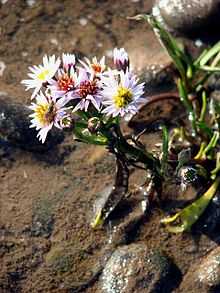Tripolium pannonicum
| Sea aster | |
|---|---|
 | |
| Scientific classification | |
| Kingdom: | Plantae |
| (unranked): | Angiosperms |
| (unranked): | Eudicots |
| (unranked): | Asterids |
| Order: | Asterales |
| Family: | Asteraceae |
| Tribe: | Astereae |
| Genus: | Tripolium |
| Species: | T. pannonicum |
| Binomial name | |
| Tripolium pannonicum (Jacq.) Dobrocz.[1] | |
| Synonyms[1] | |
| |
Tripolium pannonicum, called the sea aster and often known by the synonyms Aster tripolium or Aster pannonicus, is a plant of northern Europe that is confined in its distribution to salt marshes, estuaries and occasionally to inland salt works.
It is a perennial growing up to 50 cm tall with fleshy lanceolate leaves and purple ray florets flowering from July to September. The plants tend to be short-lived and populations need significant new recruitment each year from new seedlings. There are rayed as well as rayless varieties and only the former have long blue or white florets. The rayless form is yellow. The plant flowers well into autumn and hence provides a valuable source of nectar for late-flying butterflies such as painted lady and red admiral.
References
- ↑ 1.0 1.1 Greuter, W. (2006 onwards), "Tripolium pannonicum", in Greuter, W.; Raab-Straube, E. von, Euro+Med Plantbase - the information resource for Euro-Mediterranean plant diversity, retrieved 2014-08-23 Check date values in:
|date=(help)